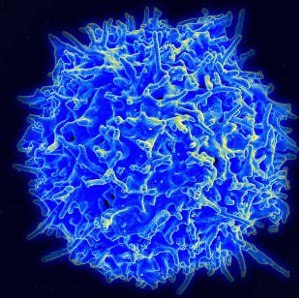Aplastic anemia patients had a 5 fold increased risk for HHV-6.
A team of researchers at Kyoto University in Japan reported that a high lymphocyte-AUC (area under the curve) was associated with a high frequency of HHV-6 reactivation, lower frequency of CMV antigenemia, and a lower risk of treatment-related mortality in 286 patients who underwent their first allo-HCT. Lymphocyte-AUC was defined as the sum of the serial absolute lymphocyte counts under the lymphocyte count vs. time curve.

Akifumi Takaori-Kondo,M.D.,Ph.D. and his hematology and oncology team at Kyoto University.
Other risk factors for HHV-6 reactivation included aplastic anemia as a primary disease (HR 5.34, p<0.001) and cord blood as a donor source (HR 3.05, p=0.006). Aplastic anemia is a rare disease in which the bone marrow is damaged resulting in pancytopenia. HHV-6, along with EBV, parvovirus B 19 and other persistent viruses, have been reported in association with anemia (Morinet 2011).
Of the 286 patients, 78 patients received a transplant from a related donor, 129 from an unrelated donor, and 79 received unrelated cord blood grafts (CBT). HHV-6 reactivation occurred in 48/286 patients (cumulative incidence: 17.5% on day 180) whereas CMV antigenemia was detected in 146/284 patients (cumulative incidence: 54.7% on day 180). There was no association between preceding HHV-6 reactivation and the subsequent occurrence of CMV antigenemia. Foscarnet prophylaxis was administered to 9 patients for 30 days post-CBT, but had no effect on HHV-6 viremia (55.6% reactivated HHV-6 with prophylaxis vs. 37.1% reactivated HHV-6 without prophylaxis).
Patients with a high lymphocyte-AUC by day 15 post-HCT were twice as likely to develop HHV-6 reactivation (HR 1.83, p=0.048). Eight patients (2.8%) developed HHV-6 encephalitis, though the authors did not specify how many of these patients received CBT, which is associated with an increased risk of HHV-6 encephalitis (Scheurer 2013). There was no difference in lymphocyte-AUC in patients with HHV-6 encephalitis vs. those without.
High lymphocyte-AUC by day 15 post-HCT was also associated with the occurrence of immune-related reactions, although in stratification analysis, high lymphocyte-AUC was associated with HHV-6 reactivation in patients regardless of whether an immune-related reaction occurred by day 15. In another stratification analysis, immune-related reactions showed no association with HHV-6 reactivation in patients with a high or low lymphocyte-AUC.
There was no association between lymphocyte-AUC and other viral infections (e.g. AdV, BKV, JCV, VZV, and EBV). However, 6/45 patients with a history of HHV-6 viremia by day 30 post-HCT had a subsequent infection with AdV, BKV, or JCV compared to 3/238 patients without a history of HHV-6 viremia who developed these other viral infections (HR 11.1, p=0.001). The authors suspected that HHV-6 infection may either be directly influencing subsequent viral infections or may just be a sign of immunocompromised status.
Past studies have shown that patients with very high HHV-6 viremia showed delayed long-term (~6 months) T-cell reconstitution and increased the risk of developing grade 2-4 aGVHD (Admiraal 2017, de Koning 2018, Phan 2018). Watanabe et al. did not analyze HHV-6 as a risk factor aGVHD, although they did observe that aGVHD by day 30 doubled the risk for CMV antigenemia. Studies have shown that the administration of steroids greatly increase the risk of HHV-6 reactivation in both alloHCT and solid organ transplantation (Phan 2018).
Contrary to expectations, the researchers found that HHV-6 reactivation occurred with rapid growth of lymphocytes independent of immune-related reactions and systemic steroid treatments.
There are several limitations to this study. The lymphocyte subsets were not ascertained, which is critical as HHV-6B prefers to infect and replicate in CD4+ T cells (Phan 2018). Furthermore, the effect of lymphocyte-AUC on symptomatic HHV-6 infections (e.g. HHV-6 encephalitis) was not examined due to the limited number of cases. Whether ciHHV-6 screening was performed was also not specified in the paper.
The researchers concluded that a rapid recovery of lymphocytes after HCT might be associated with HHV-6 expansion. It is unknown whether HHV-6 growth increased the lymphocyte counts or vice versa. The researchers plan to conduct a prospective clinical study of pre-emptive HHV-6 antiviral therapy for patients with high lymphocyte-AUC on day 15 in the future.
Read the paper here: Watanabe 2018

